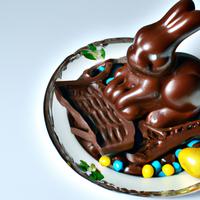
1 serving (30 grams) contains 160 calories, 2.0 grams of protein, 9.0 grams of fat, and 17.0 grams of carbohydrates.

Log this food in SnapCalorie

Nutrition Information
Calories |
1280.0 | ||
|---|---|---|---|
% Daily Value* |
|||
| Total Fat | 72 g | 92% | |
| Saturated Fat | 40.0 g | 200% | |
| Polyunsaturated Fat | 0 g | ||
| Cholesterol | 40.0 mg | 13% | |
| Sodium | 80.0 mg | 3% | |
| Total Carbohydrates | 136.0 g | 49% | |
| Dietary Fiber | 8.0 g | 28% | |
| Sugars | 120 g | ||
| protein | 16.0 g | 32% | |
| Vitamin D | 0 mcg | 0% | |
| Calcium | 320.0 mg | 24% | |
| Iron | 8.0 mg | 44% | |
| Potassium | 960 mg | 20% | |
* Percent Daily Values are based on a 2,000 calorie diet. Your daily values may be higher or lower depending on your calorie needs.
Food Attributes
Source of Calories
About Chocolate bunny
The Chocolate Bunny is a sweet, playful treat, traditionally crafted from milk or dark chocolate. Originating from European Easter traditions, it has become a global favorite symbolizing celebration. Made primarily of cocoa, sugar, milk solids (in milk chocolate varieties), and sometimes flavorings or stabilizers, it delivers a rich, creamy flavor. Dark chocolate options may offer antioxidants and lower sugar content, providing heart health benefits when consumed in moderation. However, milk chocolate bunnies often feature higher sugar and fat levels, making them less ideal for frequent indulgence. The bunny is a seasonal delight, loved for its whimsical shape and smooth, melt-in-your-mouth texture. Enjoying it responsibly, as part of a balanced diet, can keep the holiday spirit joyful without overloading on calories or sugar.



